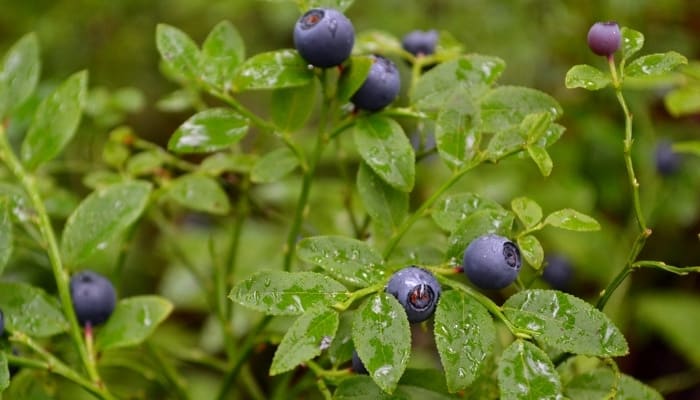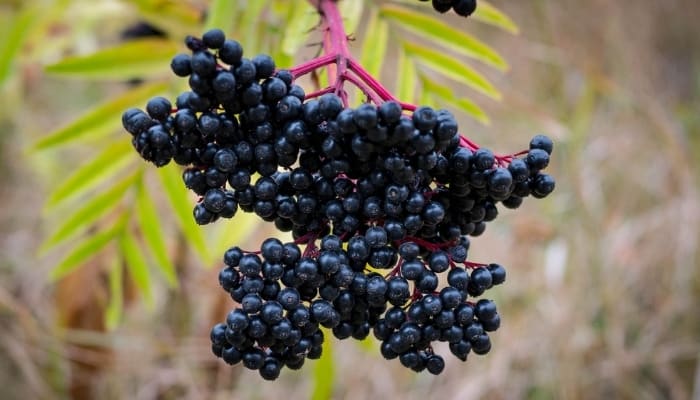Elderberry and blueberry fruits may appear similar in their blue color, but they can easily be distinguished from one another. This is because they have significant differences in all other aspects.
While you can eat as many blueberries as you like, any way you like, elderberries have to be cooked and consumed in small amounts.
What’s the difference between blueberries and elderberries? Blueberries come in lowbush and highbush varieties. The fruits are blue when ripe with a flared crown at the end and a sweet taste with a touch of acidity. Elderberries have several species, all with clusters of fruits that can be black, blue-purple, or red with a tart and slightly bitter taste.
It’s not just the taste and color of the ripe fruits that distinguish these two very different plant species; they have a lot of differences in the shape of the plant, the health benefits, and their applications.
Read more to learn about the differences between elderberries and blueberries.
Elderberry vs. Blueberry: Plant Identification
Admittedly, blueberries are more popular than elderberries and for many good reasons. One of those reasons has to do with the shape and size of the plants themselves.
Elderberry Plant

The elderberry plant is a bush that grows between 6 and 10 feet. The leaves are large and broad with a feather-like shape with 5 to 7 leaflets.
The average leaf grows to about 12 inches long, although some species will only have 2-inches long leaves.
They bloom in the early spring with saucer-like cream flowers. All elderberry species are poisonous, and while the ripe berries can be eaten, they should be cooked before consumption.
Blueberry Plant

The blueberry plant is a shrub that comes in two varieties. Lowbush blueberries grow between 1 and 2 feet tall and are 2 to 3 feet across.
Highbush blueberries grow up to 6 feet tall and 10 feet wide. The plant develops underground rhizomes that create a vast network and allow it to grow horizontally.
Some blueberry plants are deciduous while the others are evergreen. The leaves are ovate and grow to about 3 inches long and 1 inch wide.
The flowers are bell shaped and can be white, pink, or red depending on the species. These plants prefer sandy or loamy soil.
Elderberry vs. Blueberry: Berries
When it comes to the berries of both the elderberry and the blueberry, they couldn’t be any more different. There’s no confusing those two fruits at the supermarket even if there’s no label on the box.
Elderberry Berries

The fruits of elderberries grow in small clusters and start with a green color before turning black, blue-purple, or red. They’re perfectly round with smooth and glossy, tight skin.
They have a tart and bitter taste with earthly flavors. Each berry is no more than a half inch in diameter with four tiny seeds inside. The berries ripen between mid-August and mid-September.
Blueberries

Blueberries are round with a crown flare at the end. The developing berries are green and turn blue or blue-black when ripe.
The skin is covered with a white powdery wax as protection against pests. The mature berry is a little more than half an inch in diameter and has a sweet taste with a slight tang.
Harvest time varies depending on the climate with some species ripening as early as May while others will only be ready to harvest in August.
Elderberry vs. Blueberry: Health Benefits
There’s a reason people prefer blueberries more than elderberries. Apart from the taste, blueberries are considered superfoods.
Elderberries, on the other hand, can cause stomach aches if consumed in large amounts.
Elderberry Nutrients and Health Benefits
Toxicity aside, elderberries have a long history as part of traditional medicine in various cultures. The health benefits of elderberries can be summed up in the following points:
- Vitamins: The berries are packed with vitamin C, which helps the body fight off the flu and common cold.
- Dietary fiber: Although the body doesn’t benefit from dietary fiber, the good bacteria in the guts feed on it to promote better digestion and a strong immune system.
- Phenolic acids: These are antioxidants that prevent the damage and deterioration of the cells in the body.
- Anthocyanins: Another antioxidant that’s responsible for the blue-purple color of the berry. It’s an anti-inflammatory compound that strengthens the immune system and fights off infections.
- Skin protection: Elderberries have been used to heal skin blemishes and eczema. It also protects the skin against the damage of UV radiation.
- Improved urination: Some studies on rats showed that extracts from the elderberry flower improve urination and salt discharge.
Blueberry Nutrients and Health Benefits
Not to be outdone, blueberries have a whole set of health benefits that got them a place on the superfoods list. Here are some of those health benefits:
- Vitamins and nutrients: Blueberries contain high concentrations of fiber, vitamin C, vitamin K, and manganese. They also contain other vitamins and nutrients in smaller amounts.
- Prevent DNA damage: As a superfood with a high dose of antioxidants, blueberries preserve the integrity of our DNA. This can delay the aging process and prevent cancer.
- Reduce bad cholesterol: Bad cholesterol (LDL) is one of the main causes of heart disease. Blueberries have antioxidants that bind with the free radicals in the blood to bring the levels of LDL down.
- Lower blood pressure: There are indications that consuming one cup (148 grams) of blueberries a day can bring blood pressure down to normal levels.
- Improve memory: Although the results of the studies are not conclusive, there’s some evidence that adding blueberries to your diet can improve brain functions and memory.
- Anti-diabetes: Blueberries contain anthocyanins that regulate the sugar levels in the blood and prevent the sugar spikes that put a strain on the pancreas and lead to diabetes.
Elderberry vs. Blueberry: Uses
Thanks to the differences in the taste and composition of elderberries and blueberries, they each have different uses.
Elderberry Uses
Many elderberry species are quite toxic if the berries are consumed raw. It’s recommended that you cook the berries to remove all traces of the toxins.
Elderberry comes in different forms including supplements, extracts, lozenges, syrups, and even gummies. Many people enjoy making their own syrups and tinctures as well.
Elderberry is mainly used as a health supplement to fight off the flu, improve skin health, and protect against UV rays.
It’s also used to relieve back pain, leg pain, sinus problems, and chronic fatigue syndrome among others.
Blueberry Uses
Blueberries can be consumed raw, crushed into smoothies, baked into pies and cakes, squeezed into a refreshing juice, or taken as a supplement. It also goes into candy, gummies, and cocktails.
You can add it to your fruit salad, make an infused drink, cook it into syrup, or add it to your secret BBQ sauce for its tarty undertones.
You can also garnish your frozen yogurt with a few blueberries for their visual appeal.
Related Questions:
Is Elderberry the Same as Blackberry?
Elderberries and blackberries are two different plant species with different fruits and health benefits.
While elderberries ripen into a blue-purple, black, or red color, blackberries ripen only into black. They both are used as supplements to fight off flu and the common cold.
However, blackberries have more vitamins than elderberries, including vitamins A, B, C, and E. Also blackberries are not toxic, and you won’t get side effects from consuming them raw.
Are Elderberries Easy To Grow?
You don’t need a lot of experience to grow elderberries. As long as you plant them in fertile and consistently moist soil with plenty of sunlight, you won’t have many issues with them.
Avoid sandy or clayish soil since the first doesn’t retain the moisture well while clay doesn’t drain well. Pay extra attention to pruning since elderberries have a fast and wild growth habit.
Conclusion
When it comes to elderberries and blueberries, they’re as different as night and day. Blueberries are superfoods with excellent health benefits. They also go into different dishes, sauces, and liqueurs.
Elderberries have a decent amount of vitamin C and antioxidants that make them ideal to fight off the flu and skin blemishes.

